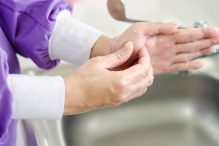Pathogens are mostly transmitted via the hands of dental personnel. Therefore,
hand hygiene is extremely important. Contaminated hands may pose
a danger to practice employees and also to patients. This means that hand
hygiene is one of the most important measures for protection of patients and
the practice team.
Hand hygiene includes the following:
• Hand disinfection
• Hand washing
• Skin protection and care
• Wearing gloves.
Hand-washing stations in the practice should be equipped as follows:
• Hot and cold running water.
• Operation of taps without hand contact (single-lever mixers).
• Dispensers for disinfectant (wall-mounted dispenser operated by arm)
• Dispensers for liquid hand-washing soap (wall-mounted dispenser operated
by arm or bottles with dispenser)
• Dispensers for disposable towels
• Dispensers for skin-care and hand-care preparations
(dispenser, bottle with dispenser or tube).
• Waste container for disposable towels.
General requirements for employees are:
• No jewellery, watches or rings (including wedding rings) on hands or lower
arms. They are taken off before starting work.
• Piercings, artificial fingernails and friendship bracelets are also not permitted.
• Fingernails must be rounded off and must not extend beyond the fingertips
to prevent perforation of gloves.
• Nail polish is not permitted (the medical director will decide whether to
permit medicated nail polish for fingernails affected by disease or to restrict
activities in the practice)
• Gloves must be worn for all activities that could be potential sources of infection
(e.g. dental treatment, cleaning and disinfection work).
Proceed as follows to disinfect hands hygienically:
• Dispense a sufficient quantity of alcohol-based hand disinfectant from the dispenser into the dry hand.
• Coat hands thoroughly with disinfectant and rub the preparation thoroughly into the hands.
• This means the inner and outer surfaces of the hands, between fingers, finger tips, nail cavities and thumbs.
• Hands become wet during this process.
When must hands be disinfected?
• Before every treatment (even if gloves are worn)
• If a treatment is interrupted
• At the end of a treatment
• Before donning gloves
• After removing gloves
• After contact with potentially or definitely infectious
substances (blood, saliva)
• After contact with contaminated objects (instruments)
or surfaces (treatment unit)
• When necessary, e.g. before eating, after cleaning the nose, after using
the toilet, after maintenance of the work area, after cleaning work.
• Apply a sufficient amount of hand disinfectant into your dry cupped hands.
• Hands have to be kept well moistened during the entire application time, add additional disinfectant if necessary.
• Perform hygienic hand disinfection for at least 30 seconds.
• Do not wear rings or watches, finger nails should be kept short and unpolished.
• Additional cleaning of hands with water and soap only in case any visible dirt remains

